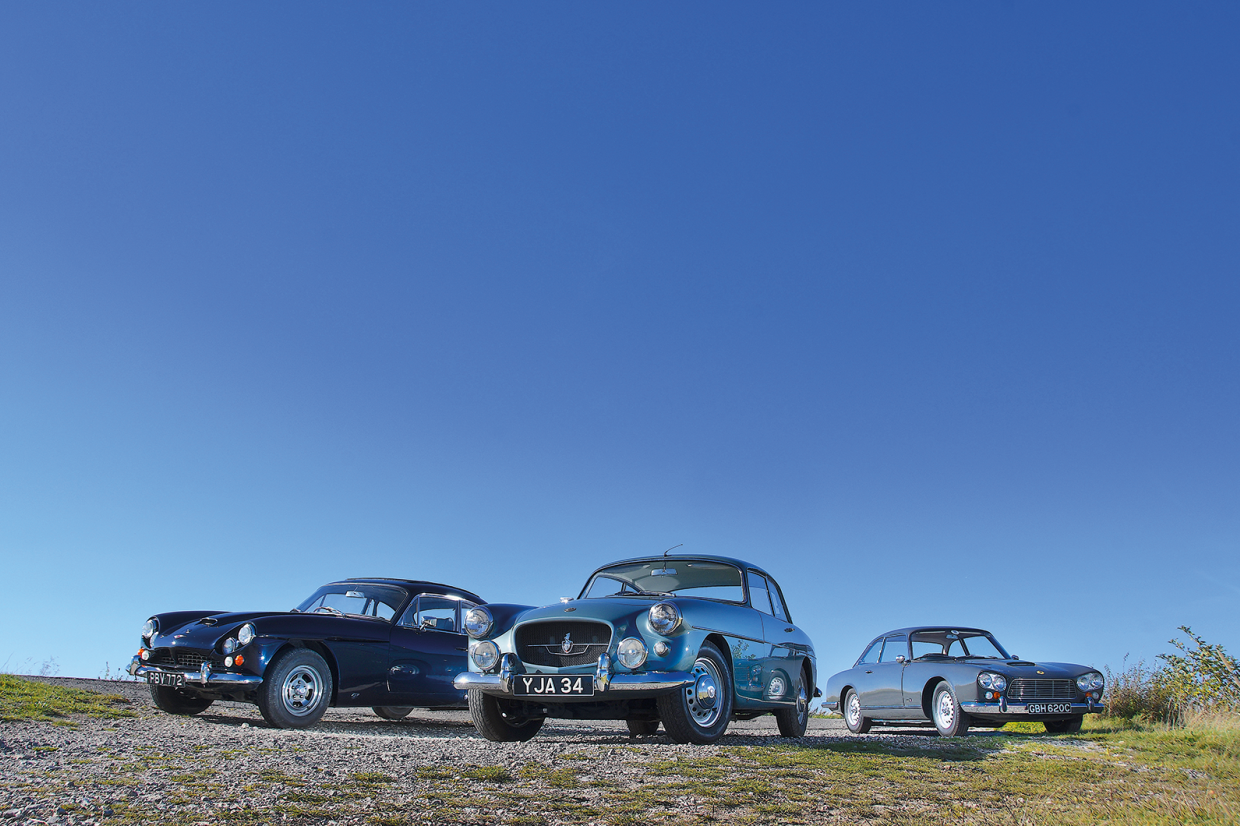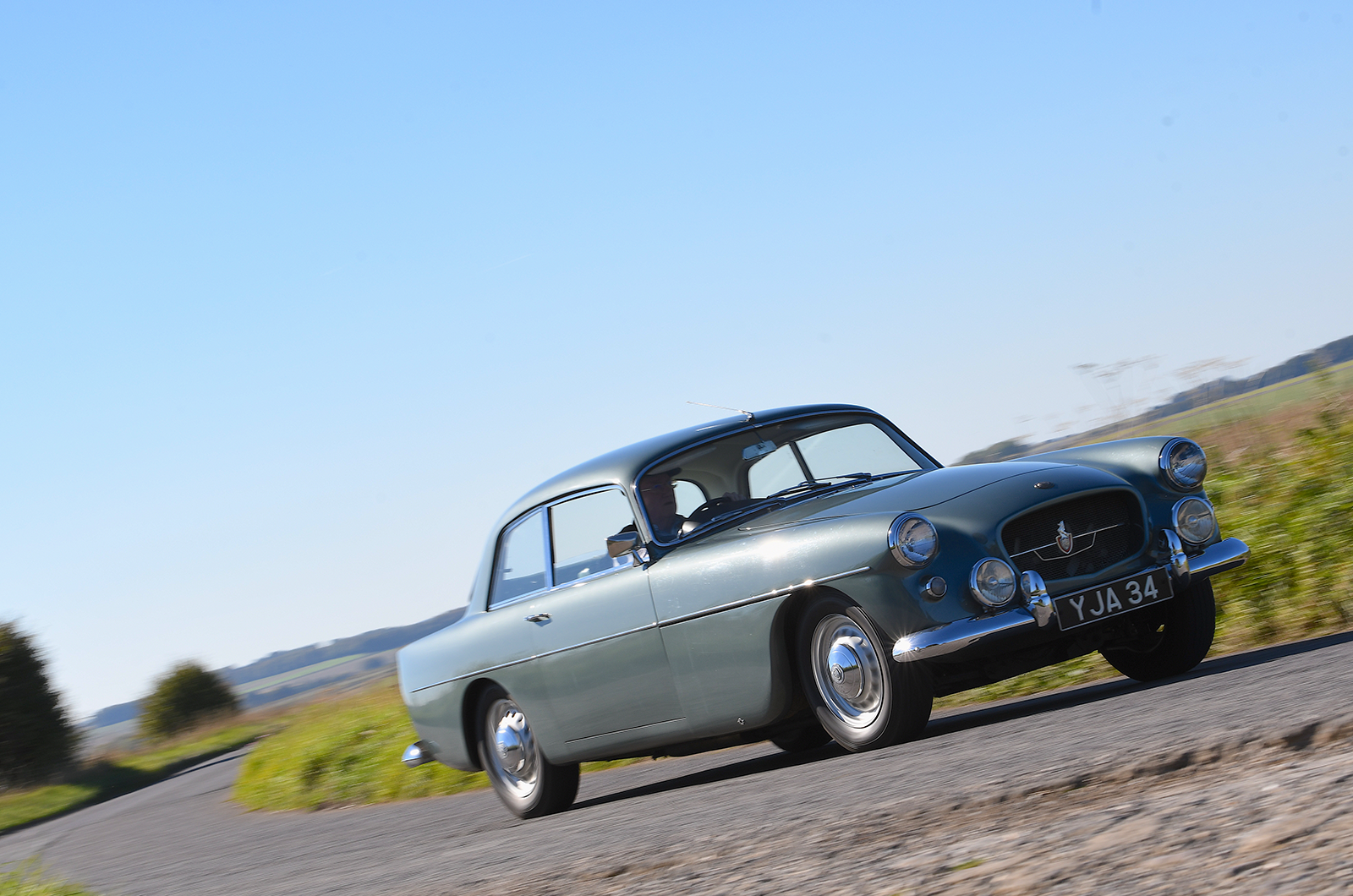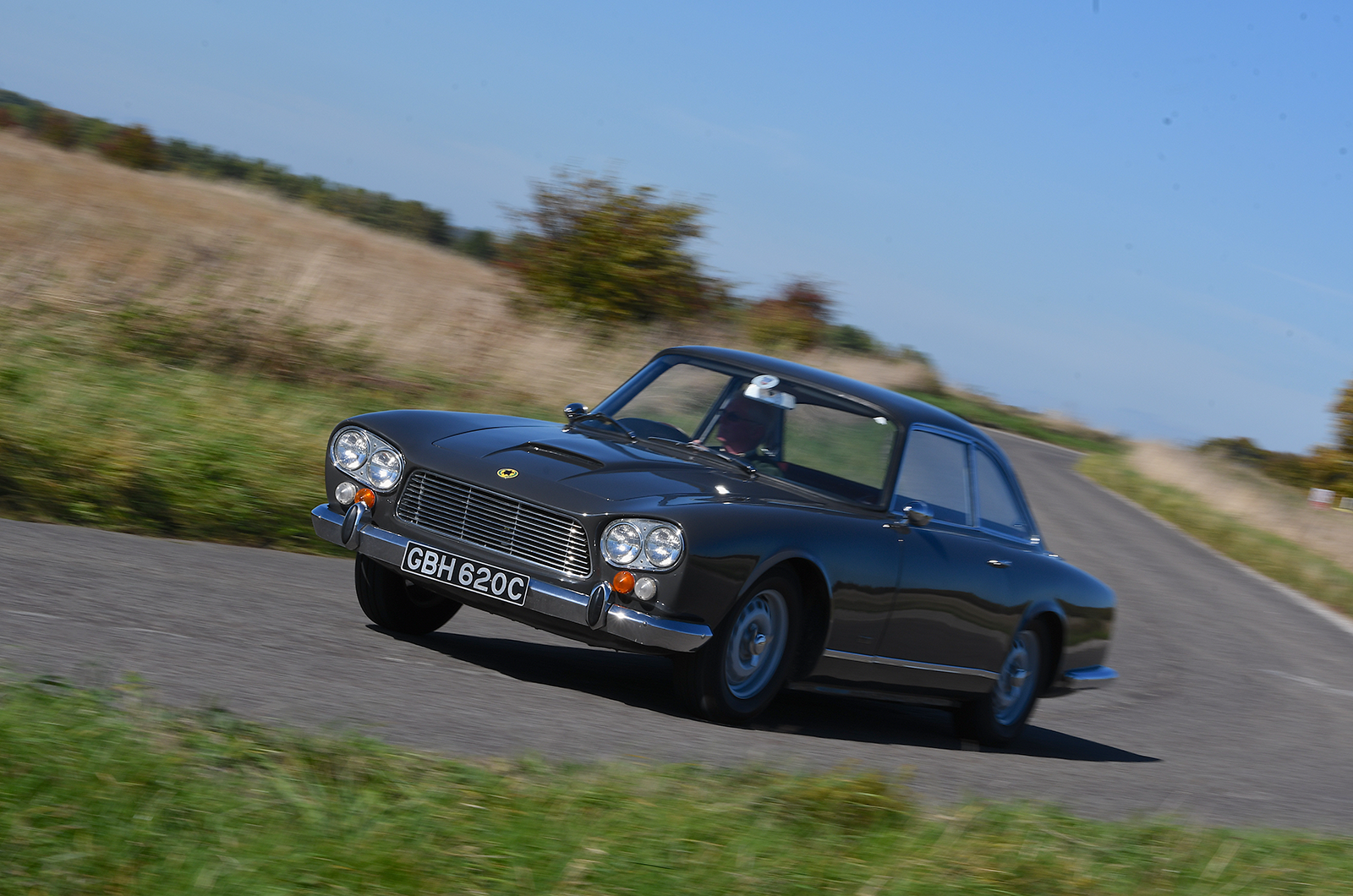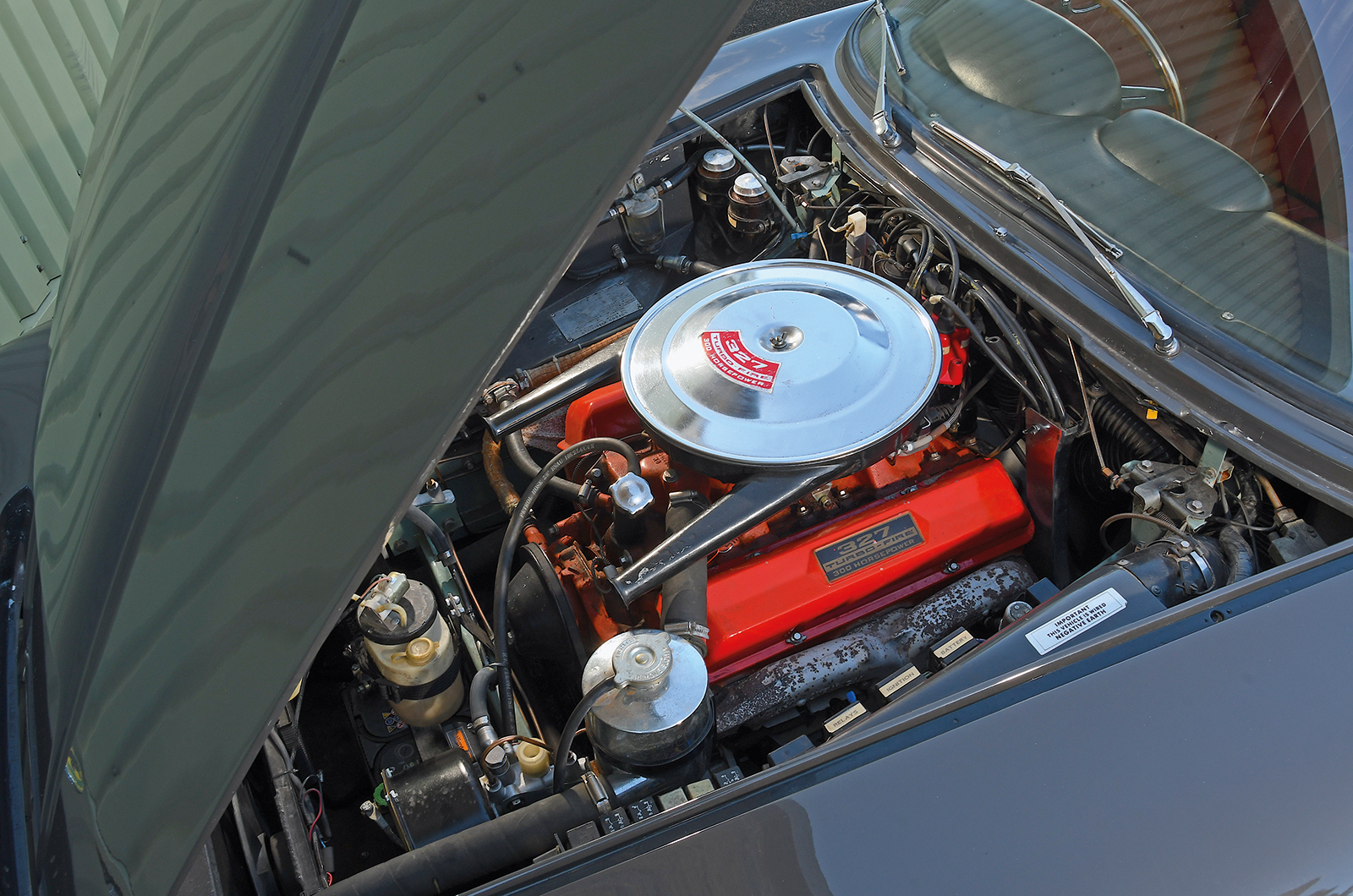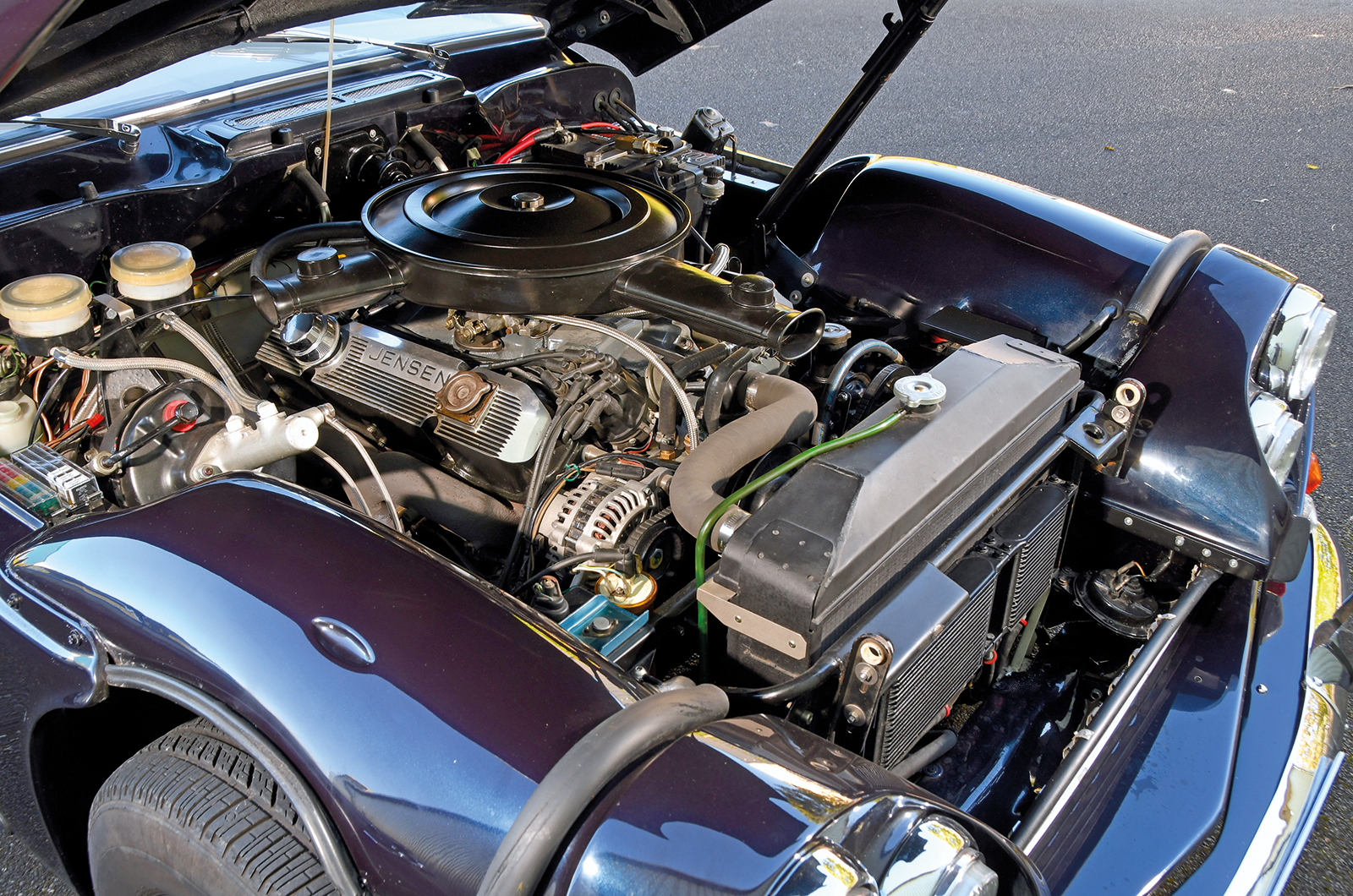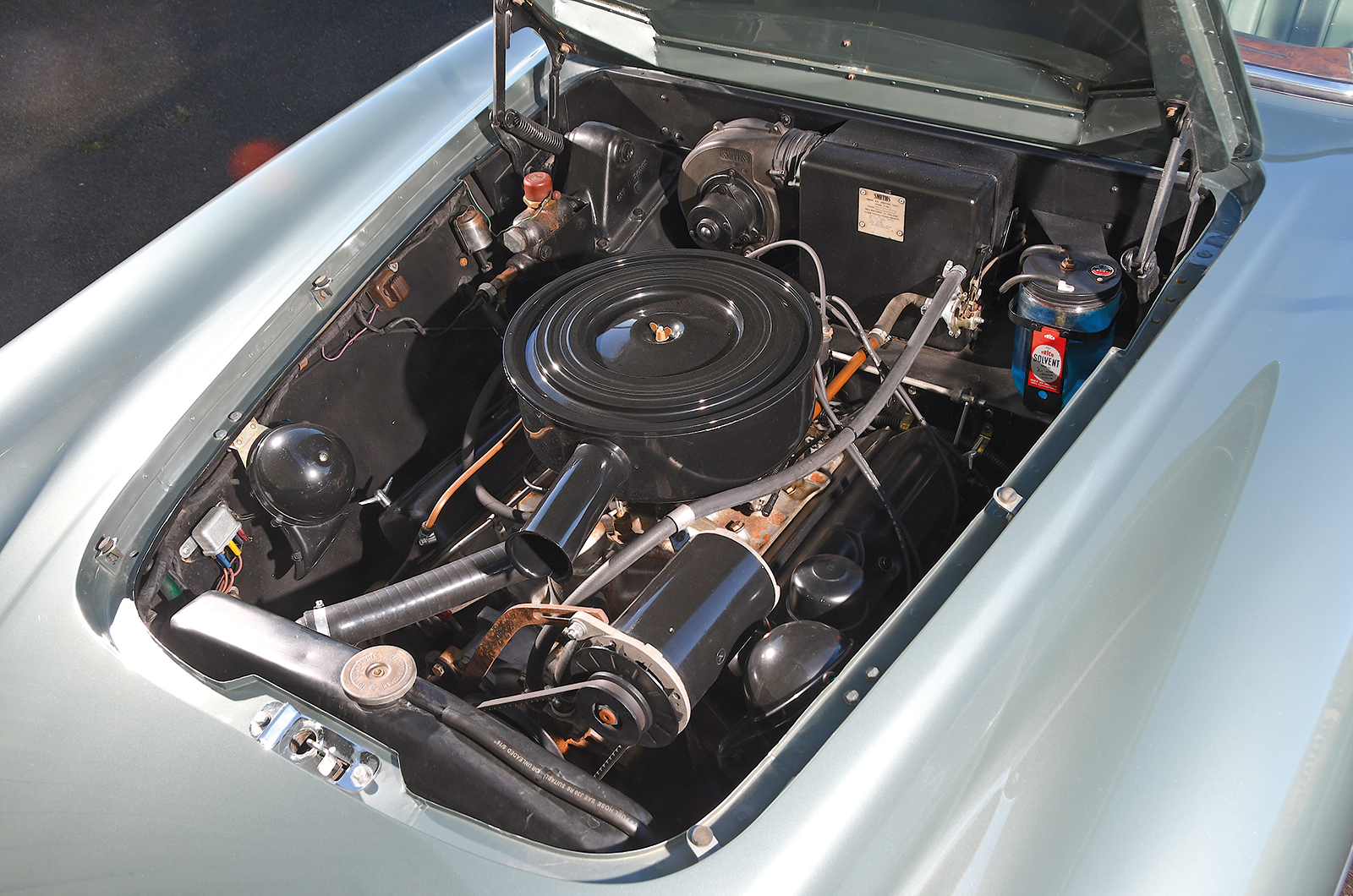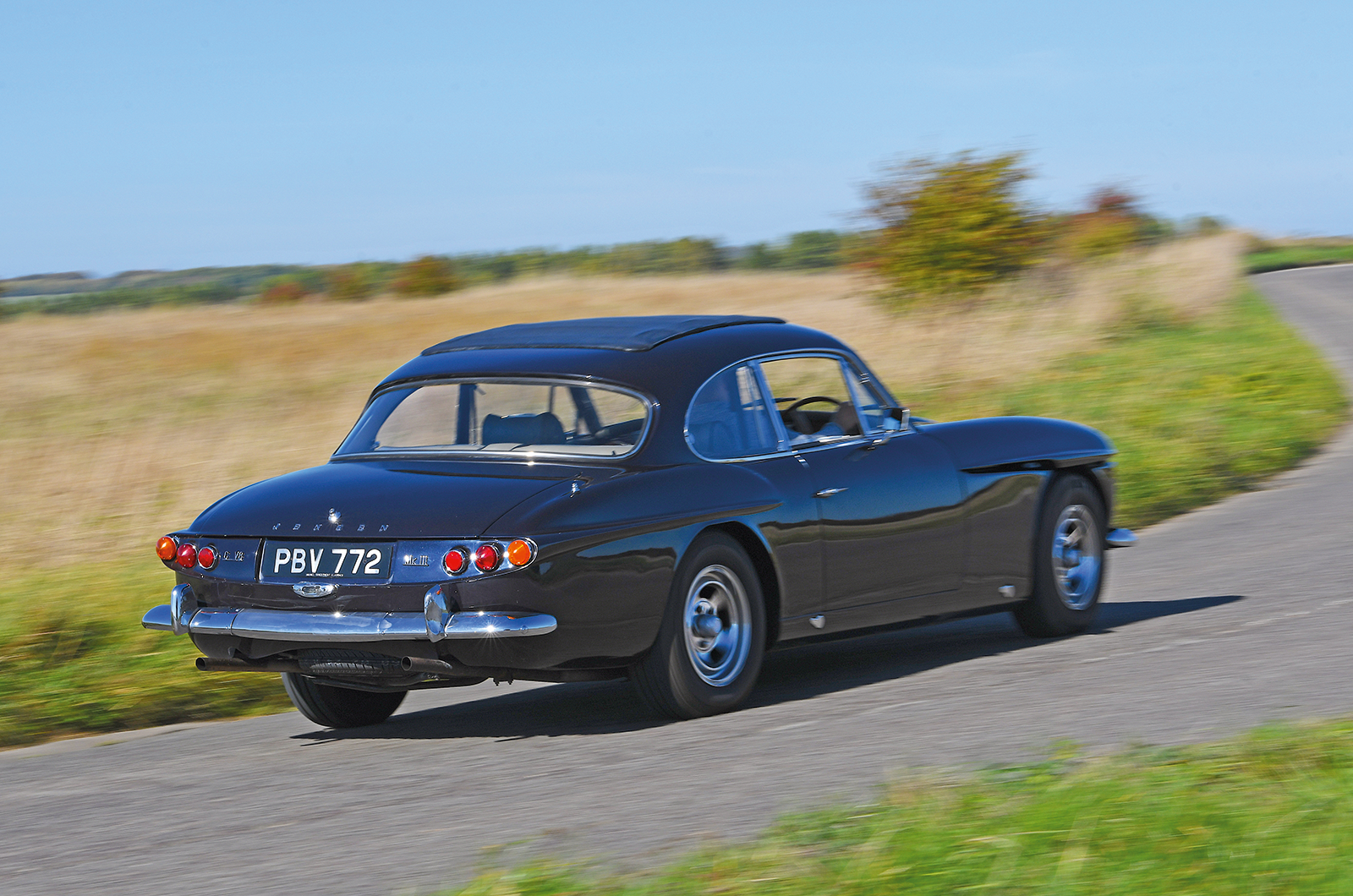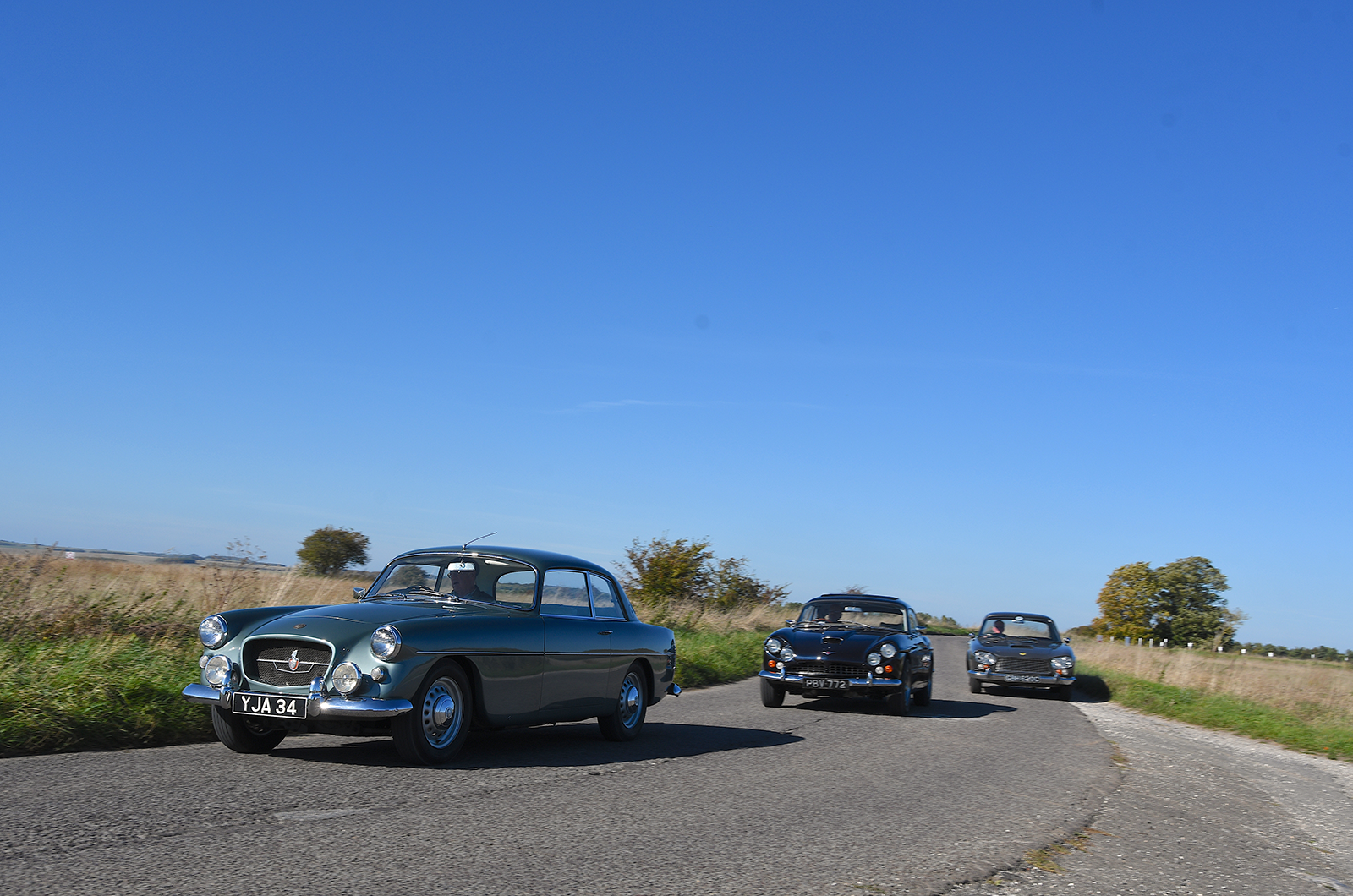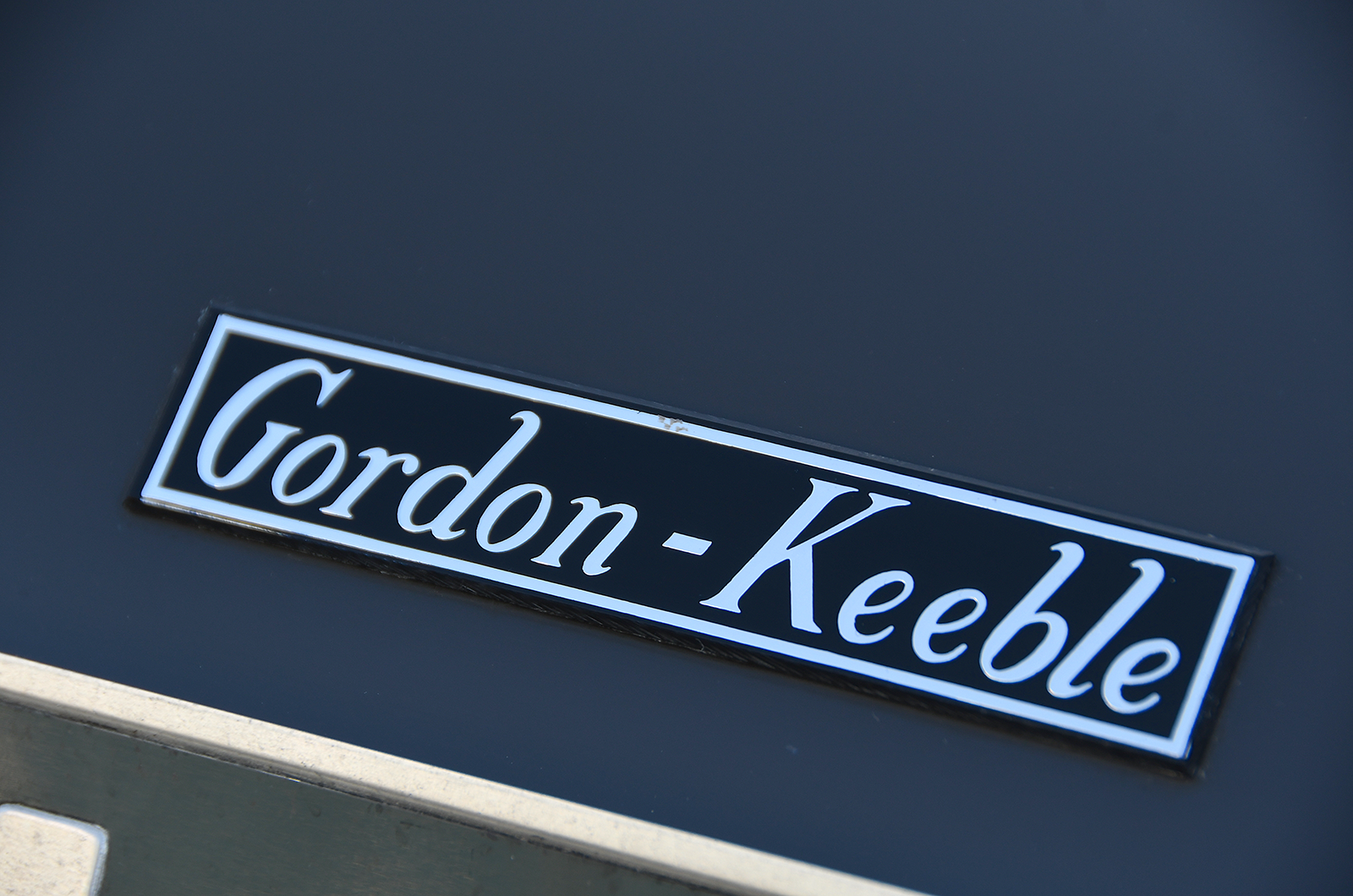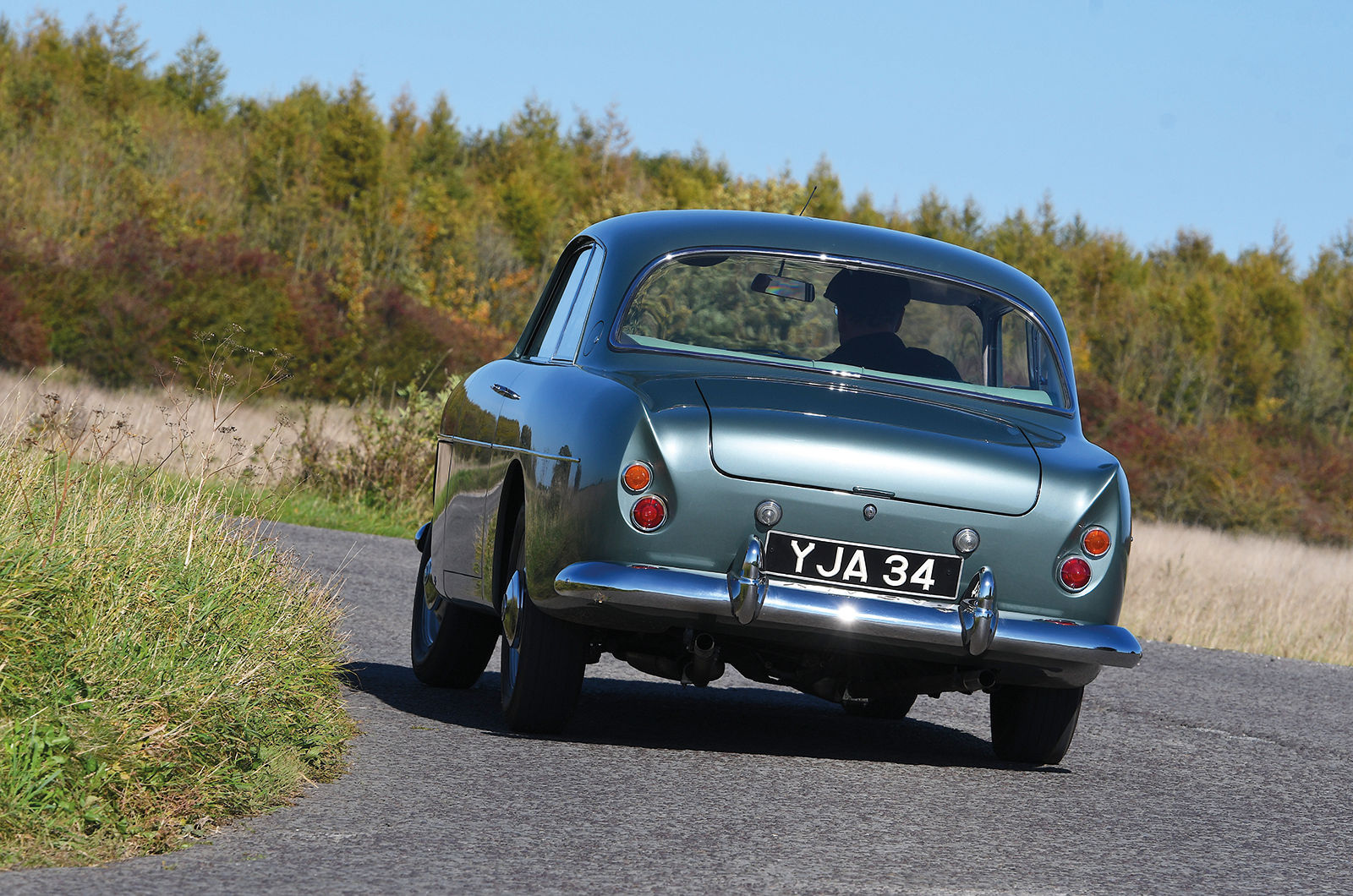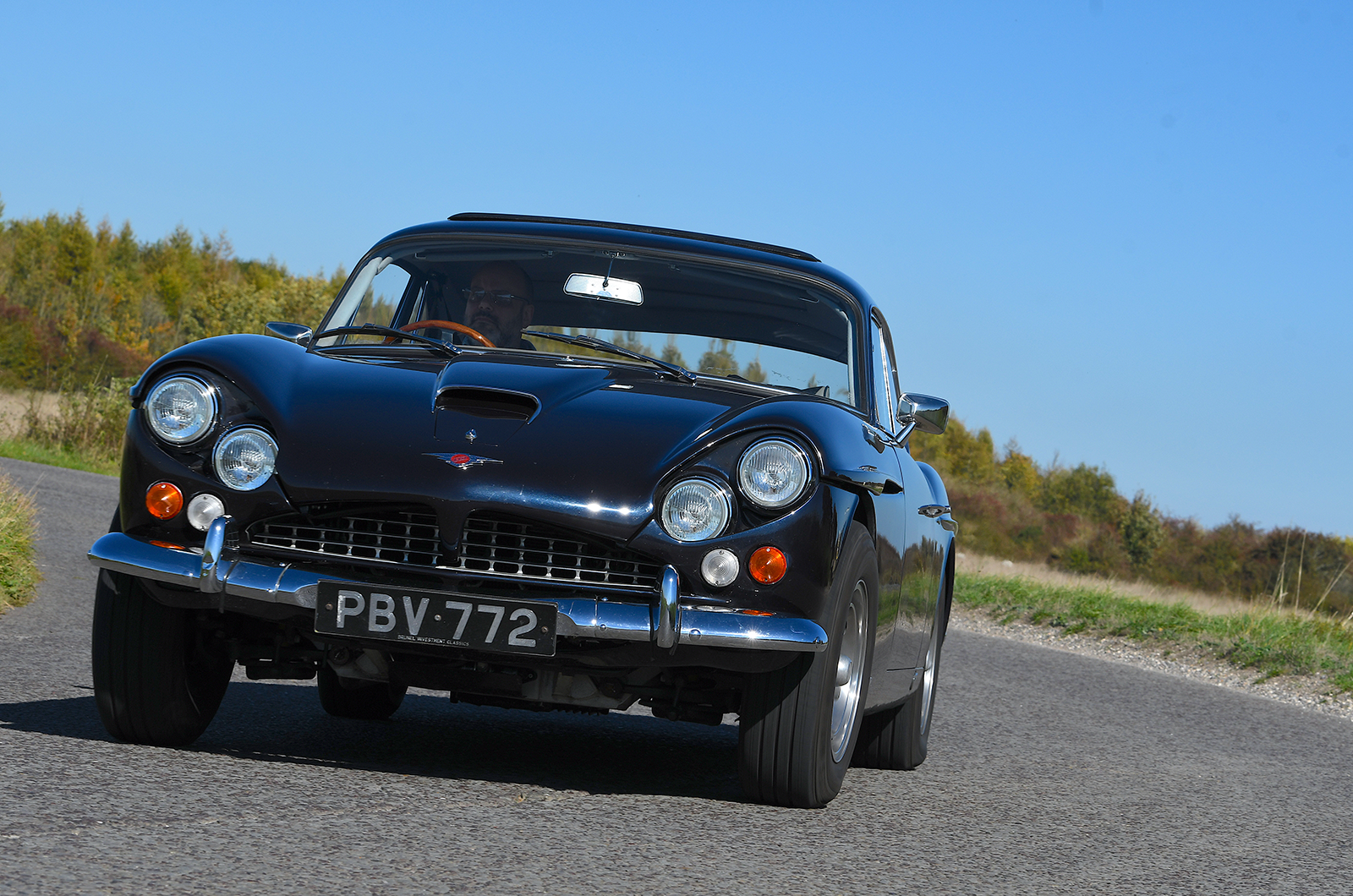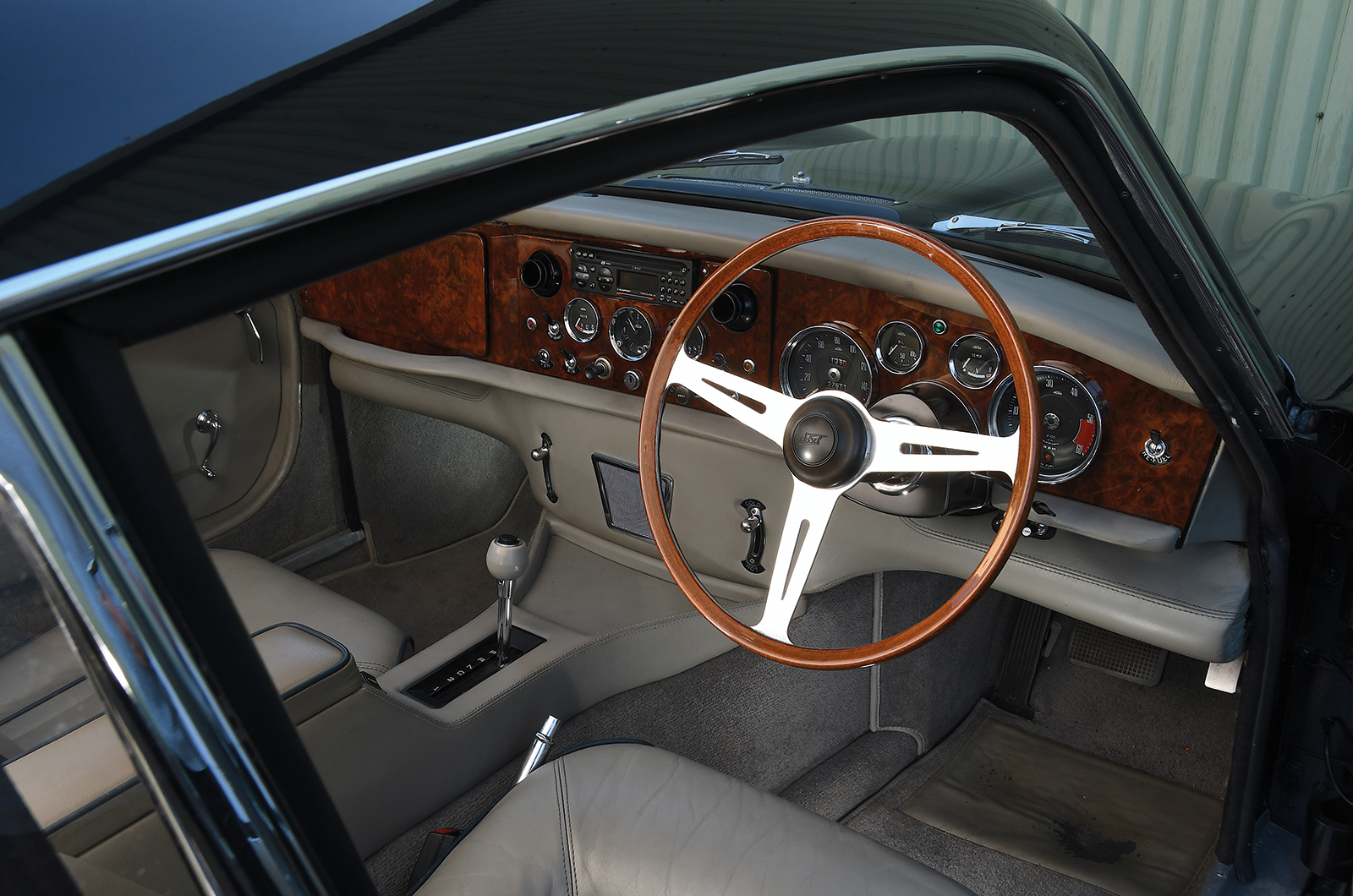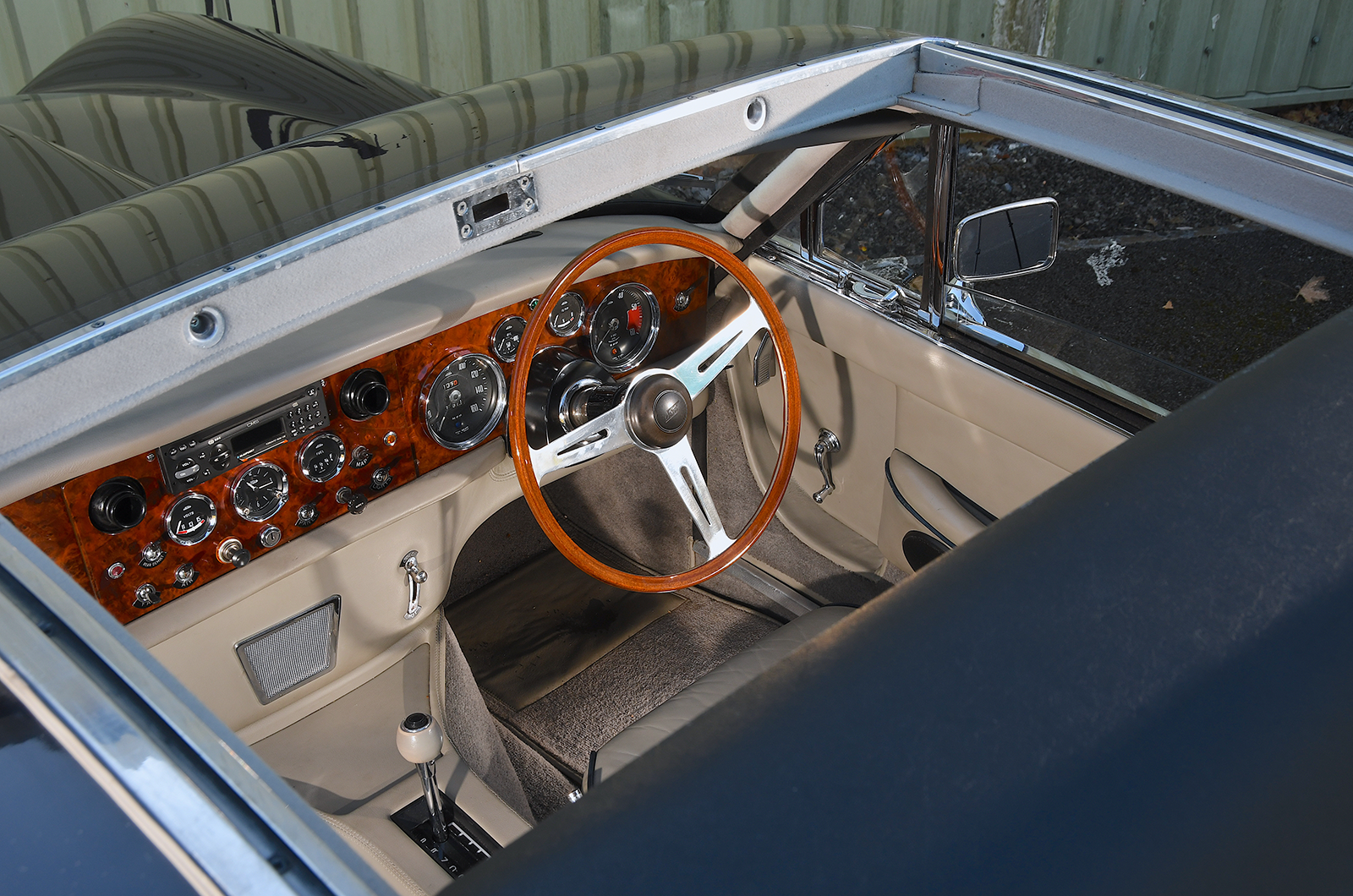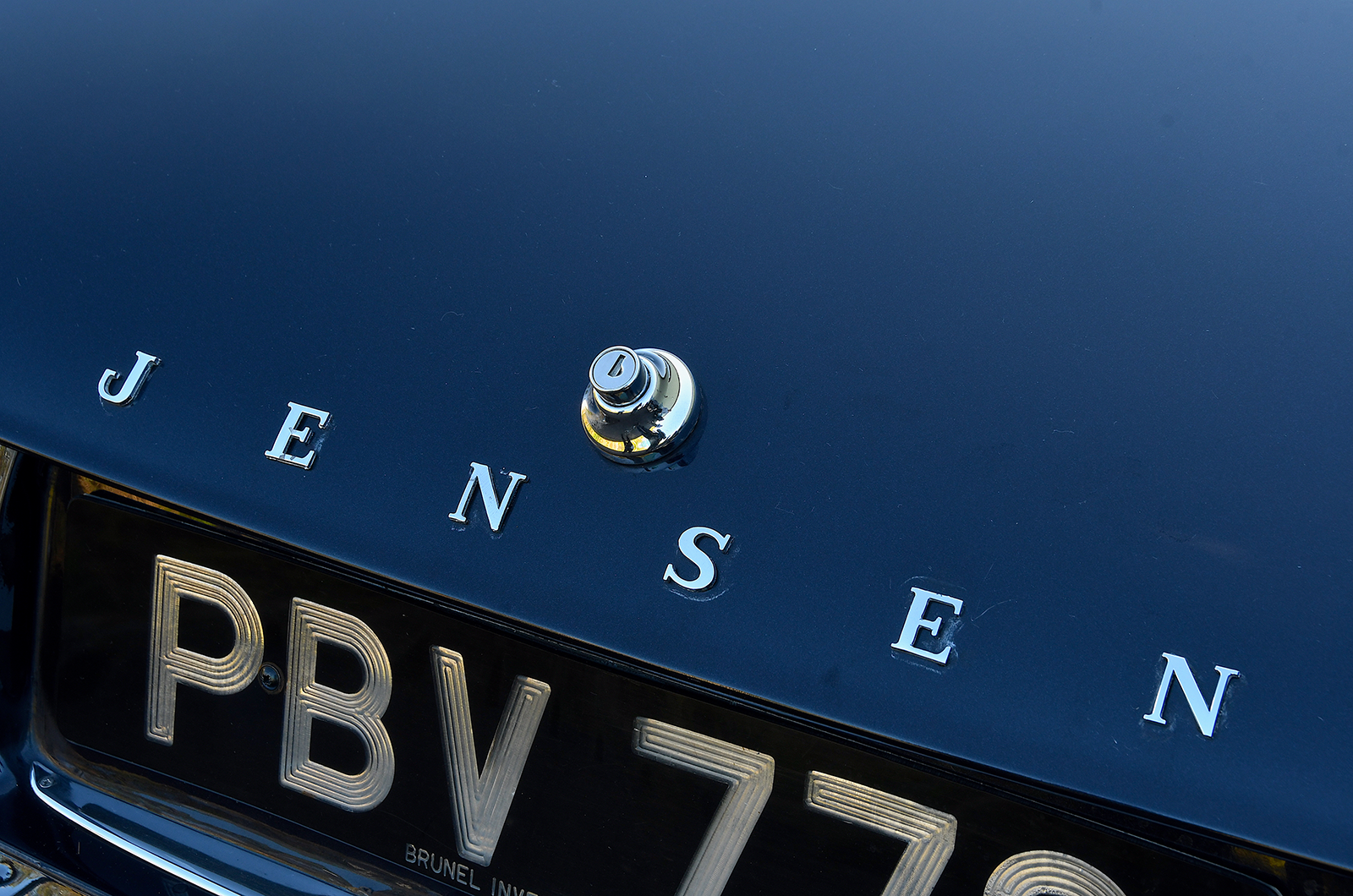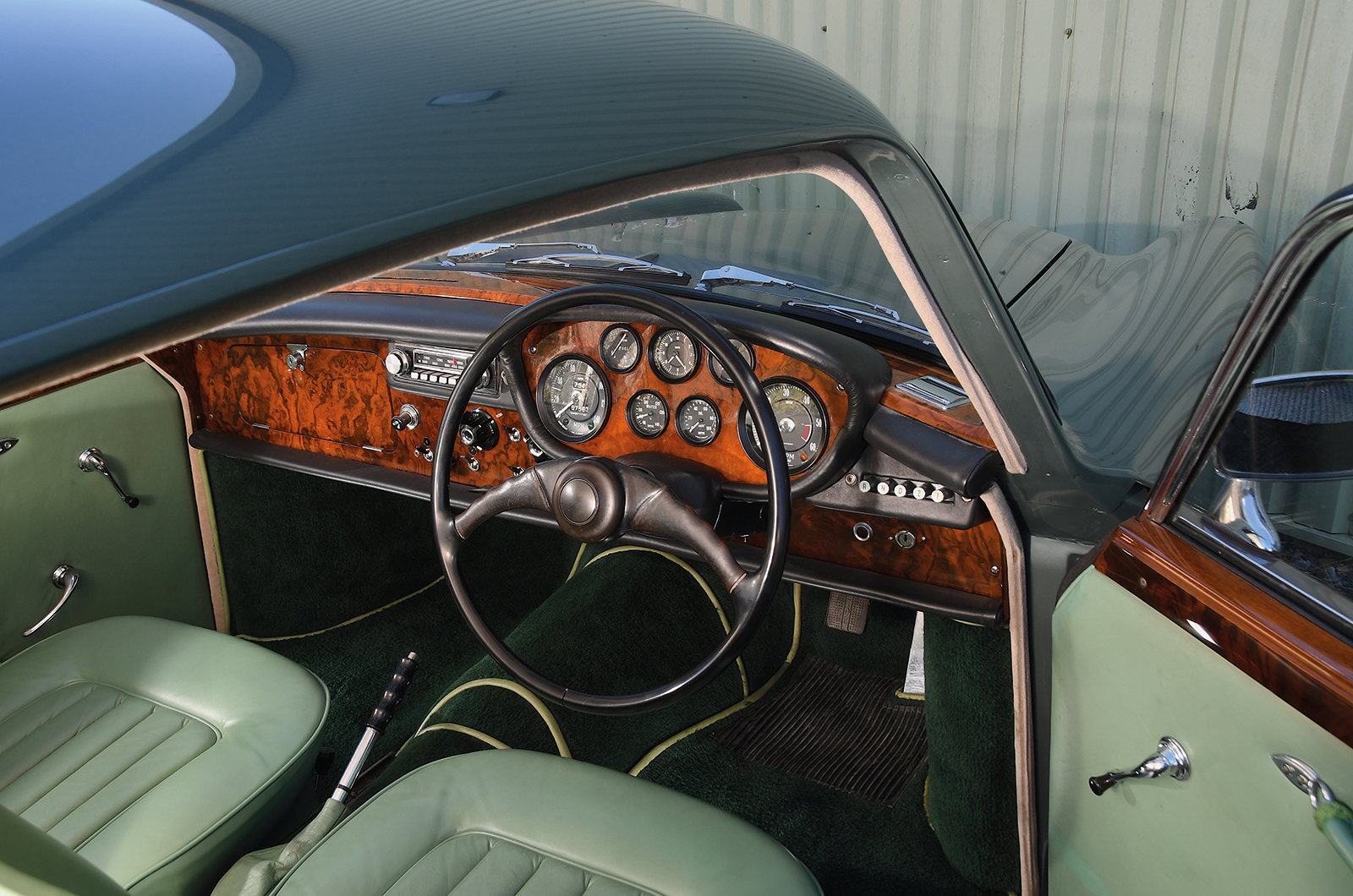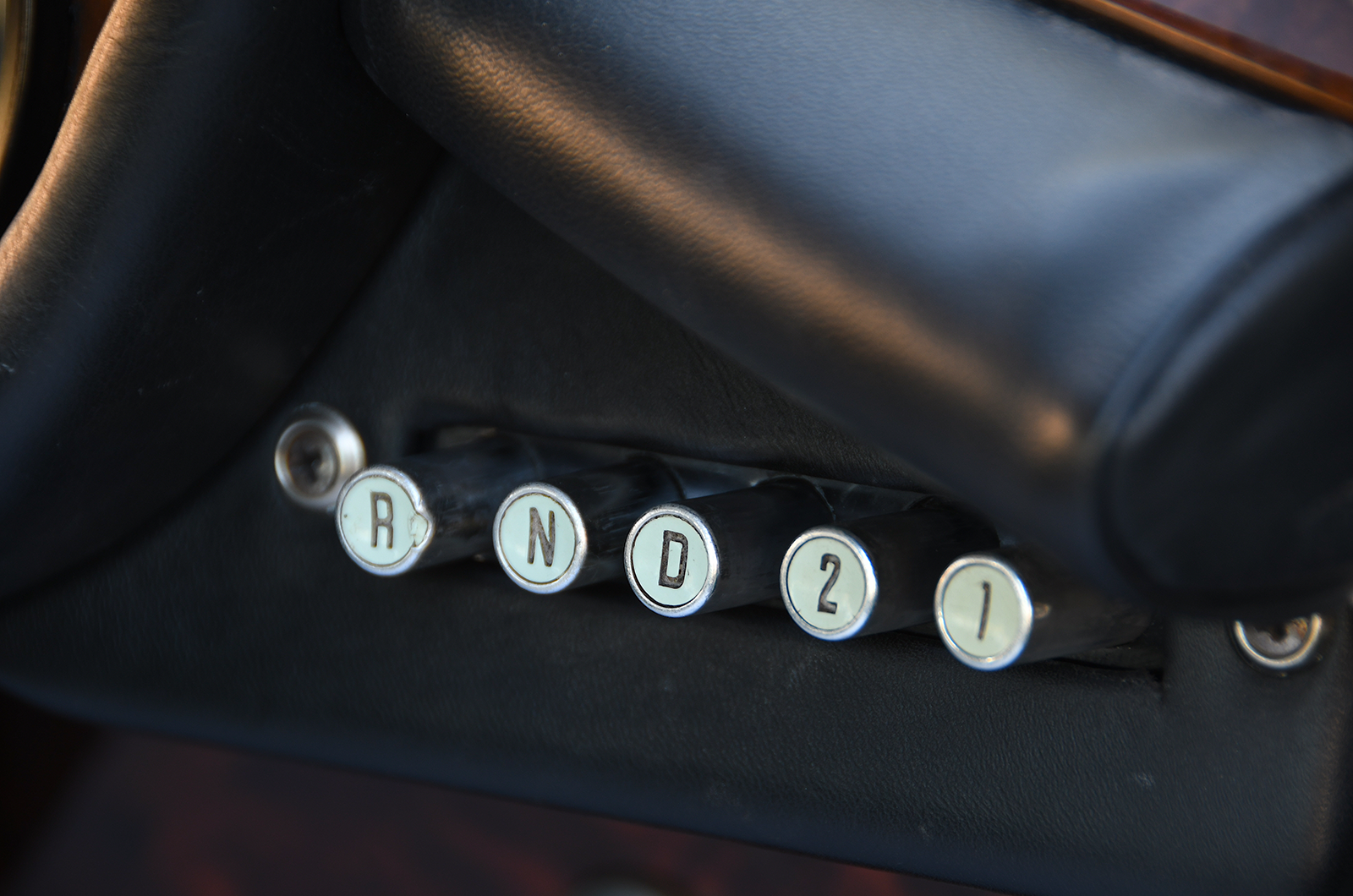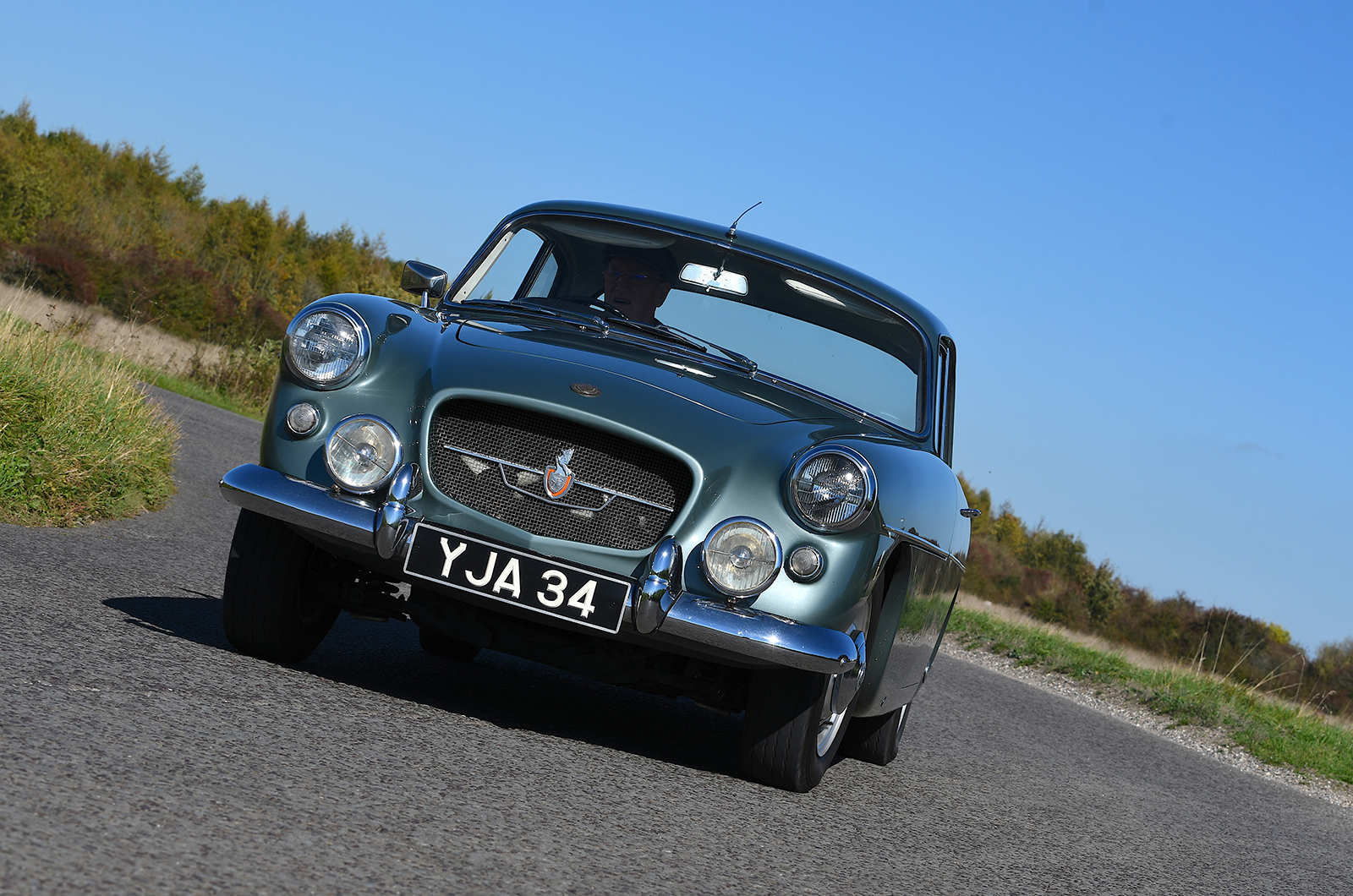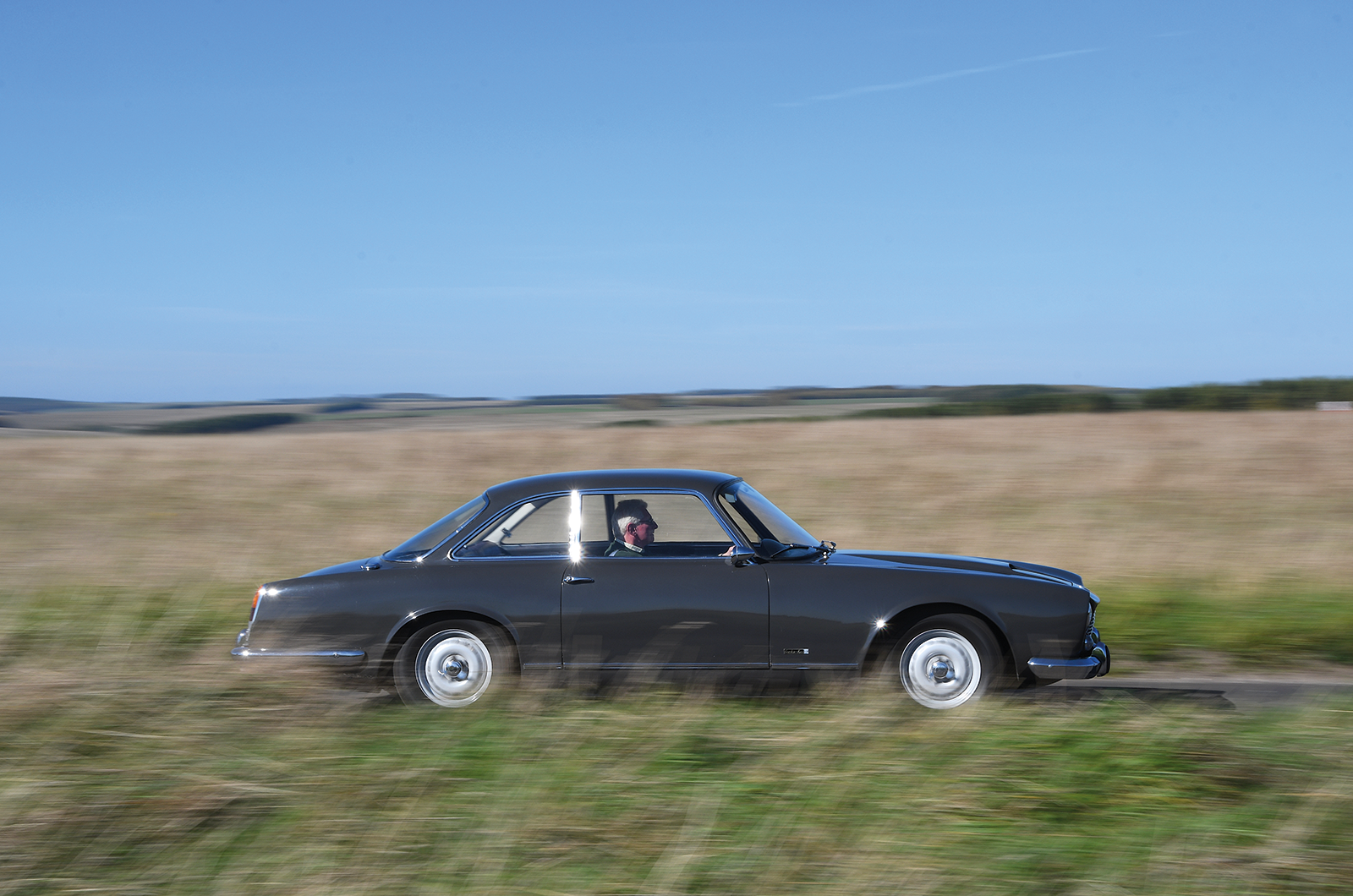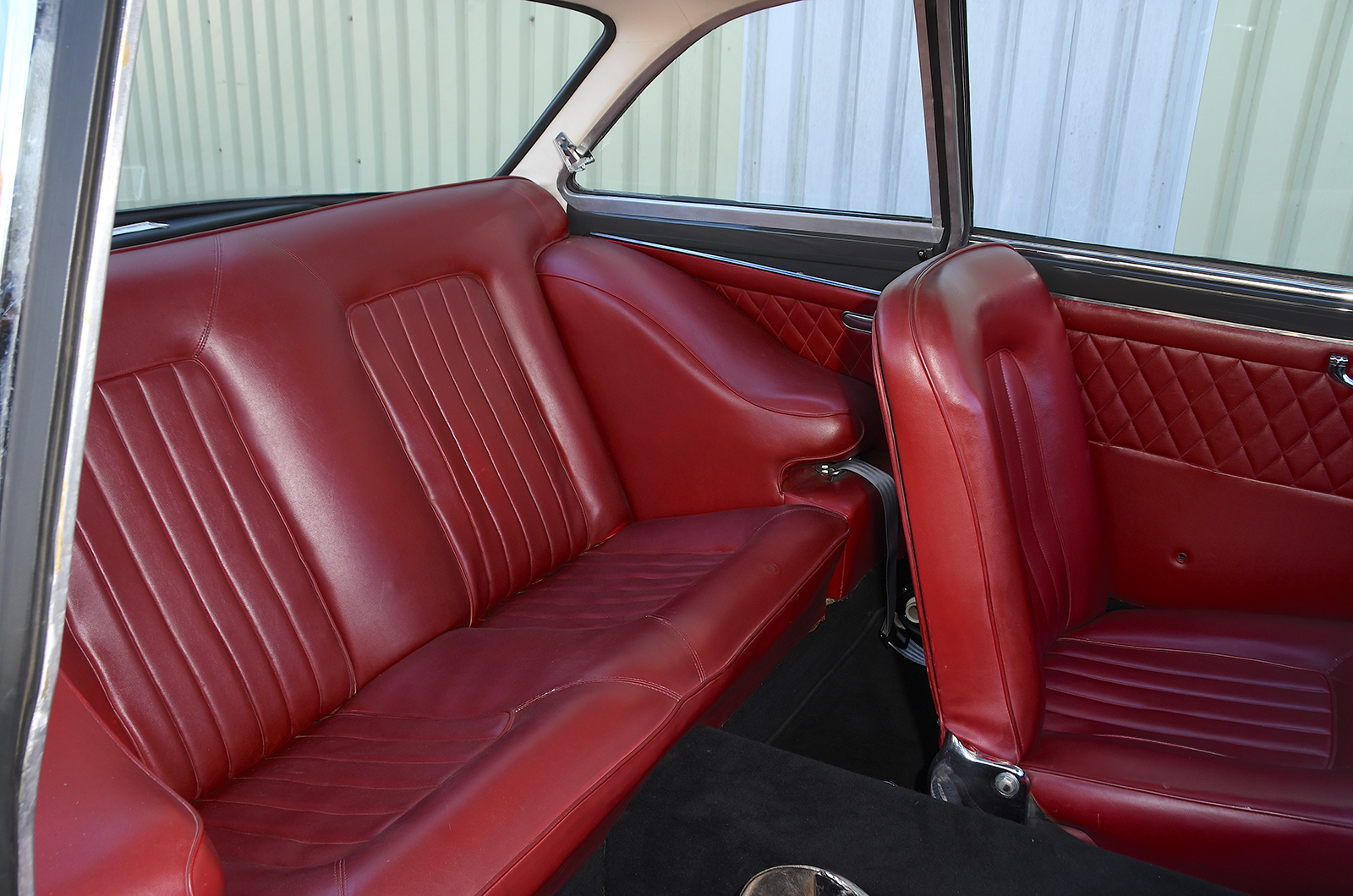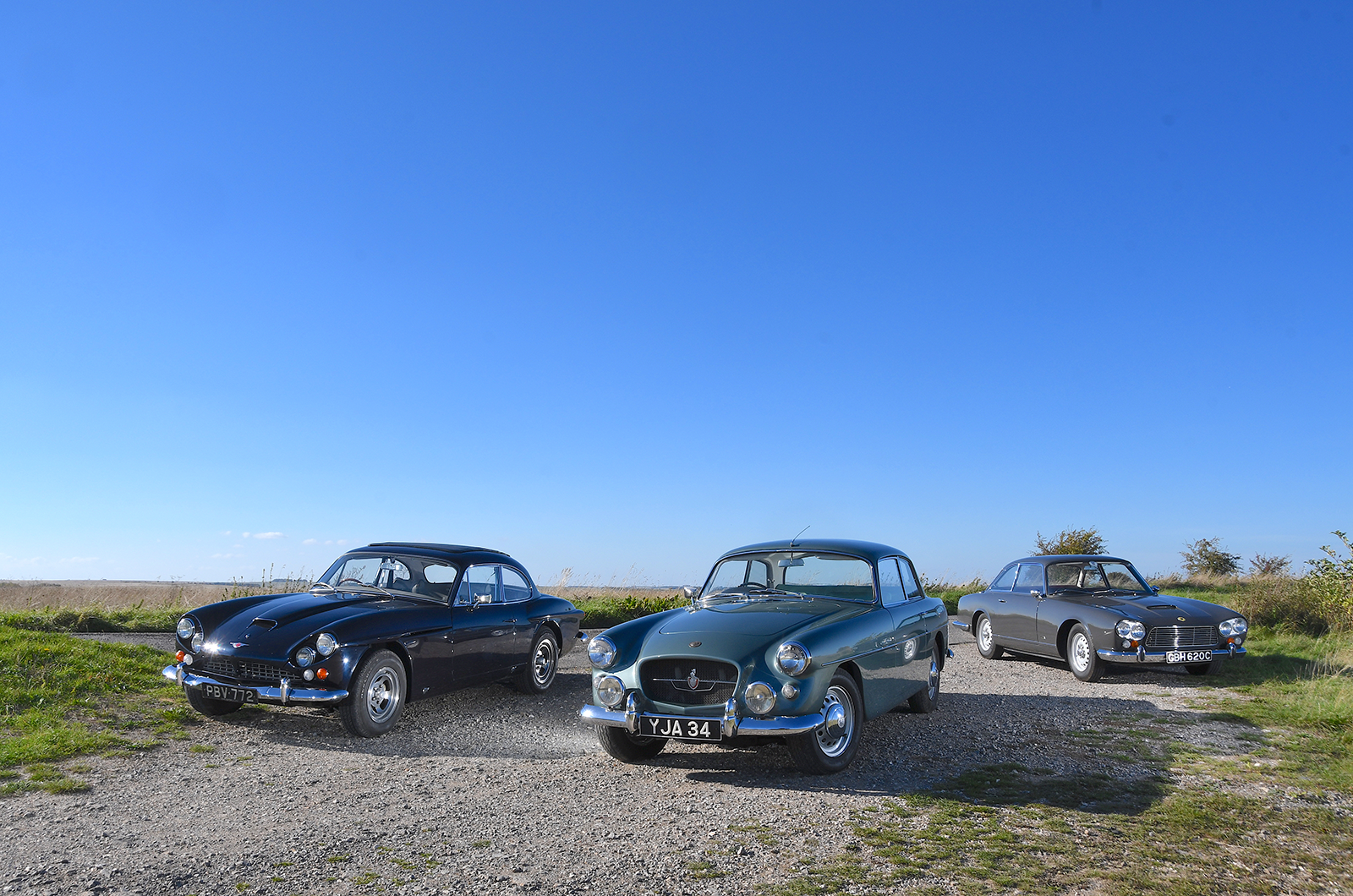Inside, the C-V8’s distinctive individual rear seats look like a pair of armchairs and the general surroundings are leather-swaddled English club land with lots of cubbyholes and lockers, and an air of quality well up with its exotic rivals.
Its padded dash and seatbelts are a reminder that Jensen was a safety pioneer in fitting such things as standard, as well as being among the first to use four-wheel Dunlop discs on the 541.
In the plastic, the C-V8 somehow looks like the dashing hero’s car. It might not be beautiful but it looks purposefully muscular, while giving you flashbacks to the rousing opening credits of The Baron.
There are those who considered the Interceptor to be a bit of hairdresser’s job in comparison, and I can sort of see why.
It is certainly a manly vehicle, with the sort of hill-levelling, horizon-drawing thrust that can still turn the majority of modern cars into distant specks in its squat rear window.
Jensen produced 499 C-V8s
A handful of manual C-V8s were built but, having driven one, it’s not difficult to see why they made only nine: as an automatic, its gears change so unobtrusively they are only betrayed by the level of hiss from the carburettor and the flick of the rev counter; 3500rpm gets you along very well for most purposes.
The Jensen corners flat and quite neutrally on its firm and mainly BMC-derived suspension, but even in the dry (with that ‘Powr Lok’ diff) its tail can be tweaked to advantage, or even disadvantage as the car’s owner apparently discovered on the way to our photoshoot.
Stable and well balanced, the C-V8 is reassuringly firm in a manner that pleases people who say things such as, “I like a car with a hard ride.”
Its hefty, precise manual steering kicks back over bumps and potholes for a no-nonsense vintage flavour, which does somehow give the C-V8 a character distinct from that of the Interceptor.
Would you pick the Bristol, the Jensen or the Gordon-Keeble?
The Bristol has a more suave personality.
It is usefully fast but not startlingly so, as if to disturb its occupants with too much acceleration would not have been quite the thing.
It wafts you along quietly in a beautifully crafted but quite plain interior, the handsome instrument nacelle framed by a big, black wheel with classic Bristol dropped spokes, hinting strongly at the car’s aircraft connections.
Naturally, the gearchange is superb – the pushbuttons to the right of the steering wheel are fun – and the ride is generally excellent in a way that filters out the worst offenders but still feels firmly controlled.
The 407 glides through country-lane curves and main-road roundabouts in a thoroughly stable and stately manner – one that its lofty seating position and the noble views down its shapely bonnet seem to dictate.
The Bristol was the most expensive of this trio when new and has a wonderful gearchange
It handles very well, in fact, only suffering in comparison with later V8 Bristols, which understeered less and, from the 409 onwards, had really good power steering to mask the sensation of ploughing on.
It is also worth mentioning that the 407 was quite a lot more expensive when new than either the Jensen or the Keeble, topping £5000.
That figure included more than £1600 of Purchase Tax, which made these cars a hard sell at the time.
Even secondhand, the 407s were never the most favoured of the V8s. In fact, they were so cheap even I owned one once!
But that was 15 years ago. Today the 407, perhaps the best looking of the V8 models, has been dragged up on the coat-tails of general classic car prices and the increased awareness of Bristol.
Even so, there can few that have enjoyed the attention lavished upon this concours example (owned by Ian Warrener, brother of Barrie), which is the best 407 I have ever seen.
The Bristol 407 can be deceptively quick on a cross-country run
The Gordon-Keeble was the car I was most looking forward to driving.
I fell in love with the first one I ever drove 30 years ago, and while subsequent exposure to them has left me not quite so overwhelmed by their steering (why is there almost zero castor return?) and other details, I still think they’re fabulous things: beautiful to look at in the manner of a Lancia Flaminia GT, but with real urge from a V8 that, on balance, feels the sweetest here.
This 1965 GK1 is the 77th built, converted to automatic in 1988 by the late Ernie Knott.
I can see why someone might want to make a self-shifting Keeble, and the maker would doubtless have offered one had the car lived on.
But to forgo the feeling of absolute control over such formidable power and torque that the original hefty, short-throw Corvette manual gave you seems a shame.
Think about 72mph in second or, if you like, slot straight from first to top at 30 or 40mph and let the torque pull you to 130mph and beyond.
“At £2798 on launch, many speculated that the Gordon-Keeble was too timidly priced to make money”
By normal ’60s standards that must have felt like a jet eating up a runway rather than a motoring experience.
Thus it is appropriate that, as in the Bristol, there are aircraft overtones to the GK1’s airy cabin, not just in the appearance of its padded, quilted, seven-dial fascia, but even in terms of actual components, such as the airliner-type eyeball heating vents in the sills.
Curiously, it is the only one of these cars with electric windows (quick, powerful ones) and it doesn’t seem to matter that its seats are PVC-trimmed rather than leather.
After all, for £2798 at launch you still got a radio, seatbelts and even a fire extinguisher as standard, leading many to speculate, perhaps uniquely in motoring history, that the Gordon-Keeble was too timidly priced to make money.
The many dials and toggles inside the GK1 give it a distinctly aeronautical feeling
All but nine of the original cars are still around, an unusually healthy survival rate.
In fact, all three of these fine machines are much rarer than the Astons, Bentleys and even Ferraris and Maseratis with which they compared themselves in period (total production of all three comes to fewer than 700), and the respect they now command is reflected in their price-tags of up to £90k in this sort of condition.
Yet if you chopped in all three today for their full value, it still wouldn’t get you halfway into a DB5. So maybe, in the grand scheme of things, these are still cheap cars.
Images: John Bradshaw
Thanks to the owners and Richard Hackett of SLJ Hackett
Factfiles
Jensen C-V8 MkIII
- Sold/no built 1962-’66/499 (all types)
- Construction steel-tube chassis, glassfibre body
- Engine all-iron, ohv 6276cc Chrysler V8, Carter four-barrel carburettor
- Max power 330bhp @ 4600rpm
- Max torque 425Ib ft @ 2800rpm
- Transmission three-speed automatic, RWD
- Suspension: front wishbones, coil springs, anti-roll bar rear live Salisbury axle, semi-elliptic leaf springs
- Steering rack and pinion
- Brakes Dunlop discs
- Length 15ft 4½in (4686mm)
- Width 5ft 7in (1702mm)
- Height 4ft 7in (1397mm)
- Wheelbase 8ft 9in (2667mm)
- Weight 3332Ib (1511kg)
- 0-60mph 6.7 secs
- Top speed 130mph
- Mpg 12-16
- Price new £3491
- Price now £40-80,000*
Bristol 407
- Sold/no built 1961-’63/88
- Construction steel chassis, aluminium body
- Engine all-iron, ohv 5130cc Chrysler V8, with Carter four-barrel carburettor
- Max power 250bhp @ 4400rpm
- Max torque 340Ib ft @ 2800rpm
- Transmission three-speed automatic, RWD
- Suspension: front wishbones, coil springs, anti-roll bar rear live axle, torsion bars, Watt linkage
- Steering Marles worm and roller
- Brakes Dunlop discs, with servo
- Length 16ft 7in (5055mm)
- Width 5ft 8in (1727mm)
- Height 5ft (1524mm)
- Wheelbase 9ft 6in (2896mm)
- Weight 3640Ib (1651kg)
- 0-60mph 9.2 secs
- Top speed 125mph
- Mpg 13-17
- Price new £5141
- Price now £40-80,000*
Gordon-Keeble GK1
- Sold/no built 1964-’66/99
- Construction steel spaceframe chassis, glassfibre body
- Engine all-iron, ohv 5354cc Chevrolet V8, with Carter four-barrel carburettor
- Max power 300bhp @ 5000rpm
- Max torque 360Ib ft @ 3000rpm
- Transmission four-speed manual (later auto fitted), RWD
- Suspension: front wishbones, coil springs rear de Dion axle, trailing arms, coil springs, Watt linkage
- Steering Marles worm and roller
- Brakes Girling discs
- Length 15ft 9½in (4813mm)
- Width 5ft 8in (1727mm)
- Height 4ft 6in (1372mm)
- Wheelbase 8ft 6in (2591mm)
- Weight 3164Ib (1435kg)
- 0-60mph 7.5 secs
- Top speed 137mph
- Mpg 14-19
- Price new £2798
- Price now £50-90,000*
*Prices correct at date of original publication
READ MORE
Something borrowed: celebrating the Bristol 400
Midlands derby: Jensen 541R vs Jaguar XK150
The misunderstood genius of Jensen’s Interceptor and FF
Martin Buckley
Senior Contributor, Classic & Sports Car
